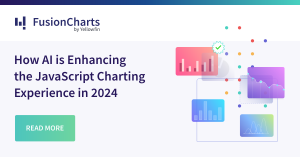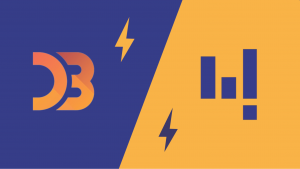Charting skills are valuable for employees in all kinds of industries. It doesn’t matter if you are reporting business analytics or pulling up health records, being able to interpret and present data will benefit you in the long run. Whether you are writing reports or making decisions that impact the rest of your team, it takes more than understanding what the numbers mean — you also have to consider correlations between variables.
Here are the 10 project suggestions we’ve put together to show you how live charts work and, more importantly, how you can use them creatively.
Table of Contents
1. What About Time Series Charts?
A time-series graph plots points while they occur in real-time collected through repeated measurements. They track changes over time. For this reason, they are particularly useful when you want to monitor your application’s performance or chart vitals on a medical device. Generally, you visualize this type of data in Python, R, or Excel. It appears as a continuous stream.Time Series Project Ideas:
- Record temperature differences over a month for a local region
- Collect network and sensor data to prepare a log for a mock IT audit
- Create a chart to depict the changing price of company stocks in the last year
2. How About World Maps?
A world map depicts geographic data from particular regions and states, as well as countries. Geospatial data is always connected to a specific location, made up of pixels or grid cells to house information about physical or cultural themes. Depending on how intricate a map model is, you can drill down into the exact statistics, by labeling points of interest as well as zooming in on them.World Map Project Ideas:
- Survey the distribution of native wildlife on a remote island
- Count how many stores belonging to a retail chain are in each state
- Learn what percent of a country’s population has received an education
3. What About Heatmaps?
A heatmap also shows the relationships between several variables by using a wide range of colors to show how variables correlate with each other on the numeric spectrum. Heatmaps make data analysis easier by presenting complex data in an abstract format. A darker shade usually represents a greater value for the measured variable.Heatmap Project Ideas:
- Keep track of user activity on a webpage–what they click on
- Assess the business impact of an incident
- Map the topography of a country through its elevation above sea level
4. How About Column Graphs?
Everyone recognizes this common visualization. The classic column graph vertically compares different sets of data. Column graphs label variables on two axes and display them as separate columns. On a column graph, you can modify one dataset without affecting others. Column graphs have a clean look and feel. This makes them perfect for datasets with few categories.Column Graph Project Ideas:
- Showing how many people have birthdays in a given month
- Compare the percent of sugar detected in high-calorie foods
- Summarize the annual sales revenue by popular brand
5. What About Bar Charts?
Bar charts are similar to column graphs, except the numbers are read horizontally. This lets you track the growth rate of each dataset, which is broken down into percentages of the whole. A legend sometimes accompanies the chart to color code different items. You can group bars into a cluster for comparison. Each bar’s length is also proportional to its size.Bar Chart Project Ideas:
- Counting the total revenue earned for a clothing store in four major cities
- Comparing the stats of the three basic RPG classes: Warrior, Mage, or Rogue
- Surveying the most popular majors studied by college students
6. How About Pie Charts?
Pie charts show fractions of a whole. Each potion represents a category shown as percentages that add up to 100%. Pie charts are useful for breaking down what goes into spending budgets or picturing which demographics participate in certain activities.Pie Chart Project Ideas:
- Keeping a record of what you did during a typical weekday
- Discover which fictional genres children like to read the most
- Measure the amount of waste produced by household/economic actions
7. What About Scatter Plots?
Scatter plots use dots on the horizontal and vertical axes in place of numeric values. A scatter plot shows possible relationships between two variables. They imply correlations. Because of this, they are ideal for identifying patterns with varying degrees of clustering.Scatter Plot Project Ideas:
- Create a plot on healthcare expenses vs. income bracket for people living in an area
- Decide if there is an actual correlation between adolescent height and weight
- Investigate factors that impact fuel consumption such as a vehicle’s average speed
8. How About Bubble Charts?
The purpose of a bubble chart is to display a bunch of variables where each bubble equates with one data point. They show values using both the position and size of the bubble. Designing a coordinated bubble chart takes practice. This is because you need to assemble the data from a table with multiple columns and add an extra dimension.Bubble Chart Project Ideas:
- Plot some bubbles showing the fertility rate vs. life expectancy of families in developing nations
- Track the number of medals won during the Olympics per country in a specific year
- Figure out how many public transportation routes are available in a state capital
9. What About Candlestick Charts?
Candlestick charts restrict vertical boxes to their opening and closing values. Candlesticks are a great way to highlight a stock’s performance and predict its long-term outlook. In general, the horizontal axis moves in real-time whereas the vertical axis is labeled by stock price. Green and red candles point to positive and negative movements.Candlestick Chart Project Ideas:
- Look up the rate of growth on an index fund to save for retirement
- Compare the price action of penny stocks with those of Google or Amazon
- Search for a chart of top-ranking cryptocurrency investments on Coinbase
10. How About Area Charts?
Area charts take a line graph and shade in the bottom. They show groups of numeric values throughout the progression of another variable. The area inside is retrieved by solving an equation over a designated range. This type of chart can have overlapping conditions and even stack areas on top of each other to show how groups differ.Area Chart Project Ideas:
- Make a stacked area chart of the quarterly profits for five different products
- Plot the revenue generated from traveling and tourism in Hawaii
- Design an infographic where the areas suggest the rising cost of materials



